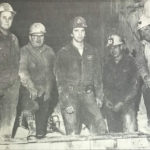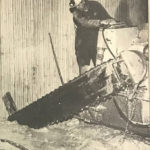By Jo-Anne Mackenzie
“It wasn’t uncommon to see 100 men in this place 15 or 20 years ago,” said Butch Beckley of Danby. Beckley, a 21-year employee of the Vermont Marble Company in Danby, has seen a number of changes over the course of his employment and a reduction in personnel is one of them. The company now employs 22 men, scattered over three shifts, at the Danby quarry.
“The turnover back then was tremendous,” Beckley recalled. “The crew just came and went.” That’s no longer the case, according to quarry superintendent Mike Blair of Danby.
“Our employees are like one big family, we have generation after generation of workers from the same families and almost no turnover,” Blair said. “Most of the people who work here are settled here.” Blair added that Danby used to be a “real company town,” when employees renew house owned by the marble company.
Vermont Marble Company is now a subsidiary of OMYA, a Swiss-based company that also owns marble quarries in Rochester and Isle La Motte, and Vermont Talc in Chester and Johnson. The Danby quarry was started in 1903 and purchased by OMYA in the mid-1970’s. Blair is the superintendent of all three quarries and travels daily to Danby and Rochester and several times a week to Isle La Motte.
Danby’s Claim to Fame
An inconspicuous hole at the bottom of Dorset Mountain serves as the entrance to a 26-acre subterraneous world of marble. Water drips steadily from the overhanging ledges and restricted entry signs dot the approach to the entrance. Blair’s office is in a trailer parked a short distance in from the entrance to the quarry.
From the entrance, it is possible to drive one mile due south, 450 vertical feet below the mountain’s peak. Work is now following an easterly direction and Blair said core samples have proven at least another 70 years in advance. “We won’t close down for a long time,” Blair promised.
All marble quarried in Danby is white, with some degree of gradation within the color and some with blue or green serpentine. The purest white, called Imperial Danby, is “the most sought after marble in the world,” according to Blair. Buildings built with Danby white include the Jefferson Memorial, the Saudi Arabian Monetary Building, and Lincoln Center. Blair addressed the desirability of Imperial Danby. “It’s 100 percent calcium carbonate and very translucent,” he said. “Italian marbles are only a certain percent calcium carbonate and heat and water can break them down.”
Green marble, Verde Antique, is quarried in Rochester and Champlain Black is found in Isle La Motte. “Black is more of an inside marble,” Blair said. “It can absorb the elements and wear down.” Danby is the only one of the three quarries which is an underground operation. “It’s the largest dimension underground marble quarry in the world,” Blair said.
Modernized Equipment
Blair attributes the reduction in personnel largely to modernized equipment. “The biggest part of the men’s time used to be spent drilling the marble out with pneumatic drills and they could only cover about 15 square feet an hour,” he said. “The last couple of years we’ve been using two Italian chain saw, which can cover about 55 square feet an hour.”
The saws Blair referred to are Fantini diamond block cutters, manufactured in Tivoli, Italy. The quarry’s two Fantini saws are water-cooled and are basically a one-person operation. Once the blade is correctly aligned, it almost runs itself, Blair said. The saws are used to make horizontal and vertical cuts through the surface of the marble.
Once the cuts have been made, the area in front of the blocks is dug out with a loader or bulldozer and a pneumatic drill is used to bore holes for the wedges. Hydraulic wedges are driven into the holes to break the blocks loose and then a forklift lifts out the individual blocks.
Days of Manual Labor
Removal of the blocks was not always so easy, according to Beckley. “There used to be 17 or 18 men pounding wedges in with sledge hammers,” Beckley said. “And I mean they did this for eight hour stretches. Then they’d get an iron bar under it and about 30 men would work it up and down until they got the block loose.”
Even after the block was finally loosened, the manual labor was not over. “Then they’d have to work a round iron bar under the block until you could get a rope around it,” Beckley said. In those pre-forklift days, stationary derricks were used to lift the blocks onto tram cars. The derricks are still in place, but Blair refers to them as “museum pieces.”
Although drivers now steer dump trucks and tractor trailers in and out of the quarry with apparent nonchalance, vehicular traffic inside the quarry is a relatively recent phenomenon. The entrance was put in some 15 years ago and prior to that renovation, an inclined railway moved the blocks within the quarry. The blocks were sent down the mountain by rail car to Route 7, where they were shipped by rail to Proctor.
Before the present entrance was constructed, employees entered the quarry from above. They went down a steep set of stairs and onto catwalks, which are still in evidence near the 80-foot ceiling. Beckley remembers the climb out well. “There were 72 steps from the catwalk to the top,” he said.
Three tractor trailer loads a day leave the Danby quarry and are taken to Proctor, where all the marble is fabricated. Individual blocks range in weight from 20 to 25 tons. “Most of the big blocks are cut into slabs for building material,” Blair said. “The scrap is made into tiles.” Blair did say that some of the blocks are cut up entirely for use as headstones, a number of which can be seen at the Arlington National Cemetery.
Safety Precautions
“Dust and diesel fumes used to be the biggest health risks,” Blair said. “Now there’s a ventilation shaft up through the mountain which can be used to blow fresh air in or suck dusty air up.” Water is used extensively in keeping the dust level down; the main road is watered down at least once a week. Blair said they pump out about 10,000 gallons a day. The water travels through a series of underground settling ponds. “When it exits the final settling pond, it’s pure enough to drink,” Blair said. Blair noted that the quarry has an excellent safety record, with only one fatality in 85 years of operation.
Mercury vapor lights are suspended from the ceiling at 50-foot intervals and most of the employees’ hard hats are equipped with miners’ lights. The man road twists throughout the quarry. There are numerous side areas where excavation has occurred and traveling through the quarry is not unlike threading through a large-scale maze.
“It takes about a week to learn your way around,” Blair said. “New men tend to stick close to someone else until they feel secure in their knowledge of the layout. People do get lost every once in a while.” Out arrows are spray with fluorescent paint at regular intervals.
Life Underground
“The temperature in the quarry hovers around 47 degrees year-round,” Blair said. “It may fluctuate two or three degrees. The humidity level is 97 percent.”
Three-year employee Tom Rollins of Rutland said working underground is not comparable to working inside or outside. “The biggest adjustment for me was getting used to sleeping during the day because I work third shift,” Rollins said. Rollins and Beckley both said they had no reservations about working underground and liked the consistency of the temperature. “I like it down here in the winter,” Beckley said. “I don’t think I could work outside anymore.”

